It happens to the best of us: we eat something that disagrees with our stomach. In this case, it’s a Miner and a handful of space crystals. There’s a lot of roughage in that particular meal. But it’s not much easier to be the Miner, suddenly trapped in the belly of the Beast! There’s only two ways out of this situation, and neither one is going to be pretty.
So, You’ve Been Eaten is an asymmetric game where one player is the Beast, using their hand of cards to drive the pace of the game, and the other player is the Miner, rolling and placing dice on their board to push back against the Beast’s digestive machinations.
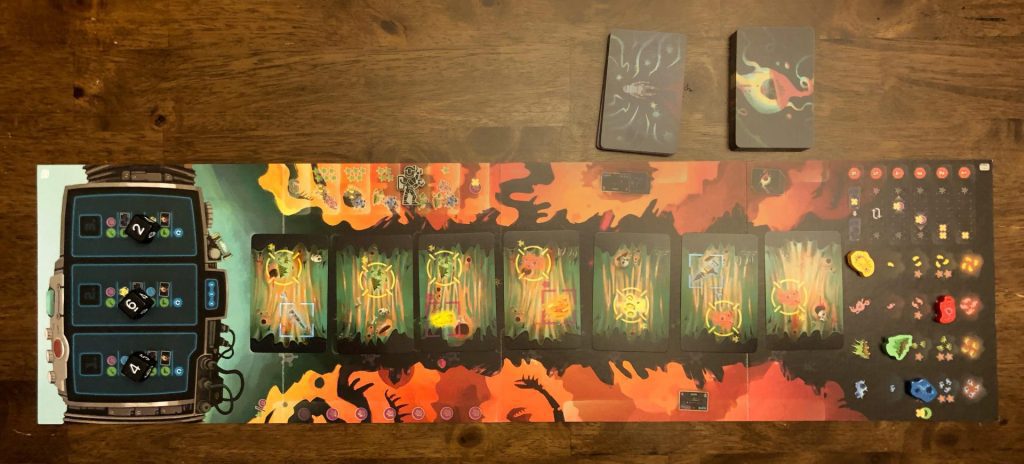
Players interact with each other through the Digestive Tract, an ever-changing column of 7 Stomach cards that lies between the two players. Every Stomach card shows one of four colors of Bacteria; most also show either a Crystal (in one of eight colors) or a Tool which the Miner can use to help escape the Beast. How each player approaches this shared area depends on which role they’re playing.

The Beast has two ways to win: by hitting the Miner four times with a single type of Bacteria or by accumulating five Immune Response Cards. The Miner wins by gathering a set of Crystals from the Digestive Tract. If none of these conditions occur before the Stomach deck is empty, players score their progress and compare totals to determine the final winner.
Miner Problems
On the Miner’s turn, they roll three 6-sided dice and assign them to various sections of their player board to manipulate the cards in the Digestive Tract. Each die’s number determines which card it will affect; the card closest to the Miner has a value of one and the furthest has a value of seven, meaning that it can’t be directly targeted. However, whenever there’s a gap in the Tract, cards shift down to fill the space.
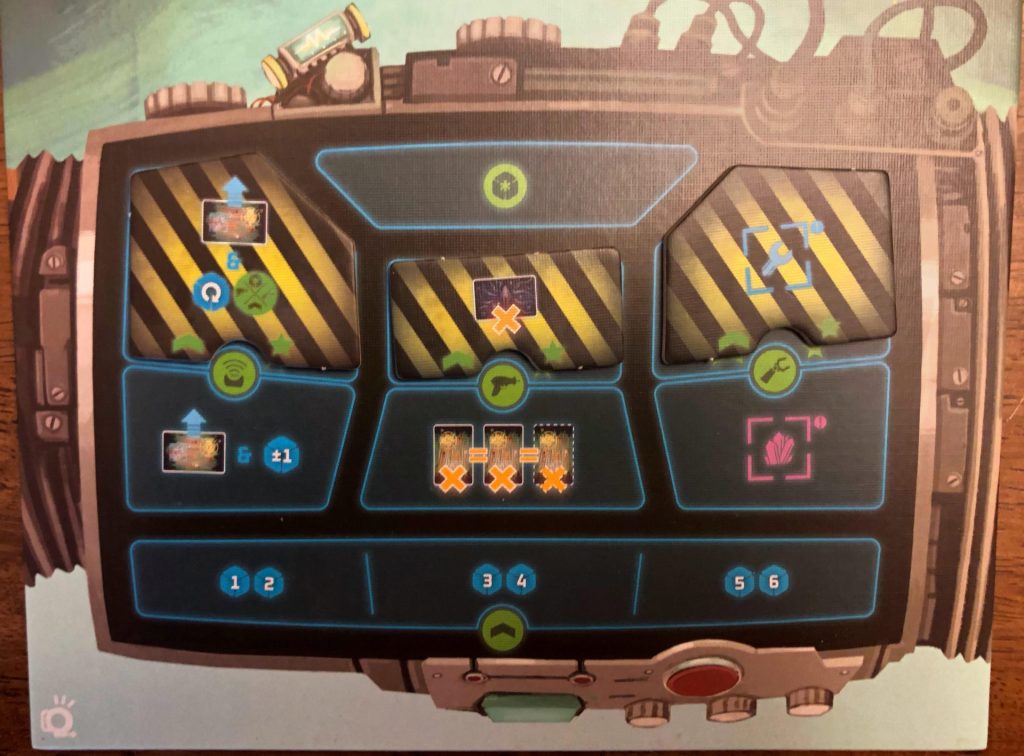
Each of the Miner’s three main abilities lets them create just such a gap. Stun, for example, allows them to move a Stomach card to a higher position in the Tract, bringing all the cards below its new position closer, while the Eliminate ability allows them to destroy two or three adjacent cards that share a Bacteria color. The most important ability, however, lets the Miner grab a Crystal from the Tract provided they don’t already have a Crystal in that color. Gathering a full set of Crystals leads to a win, so snagging them when the opportunity arises is important.
There are also three spots on the board which the player can use to upgrade their basic actions. The upgraded actions let the Miner take an extra action after Stunning, destroy one of the Beast’s Immune Response cards when using Eliminate, or grab helpful Tools instead of Crystals.
After placing and resolving each die, the Miner suffers an attack from the Beast’s digestive system. Discard the card closest to the Miner and advance the Beast’s Bacteria track which matches the color of Bacteria on the card. If it also matches the Mutation card played by the Beast on their turn, the Miner must downgrade one of their upgraded actions or lose a Crystal.
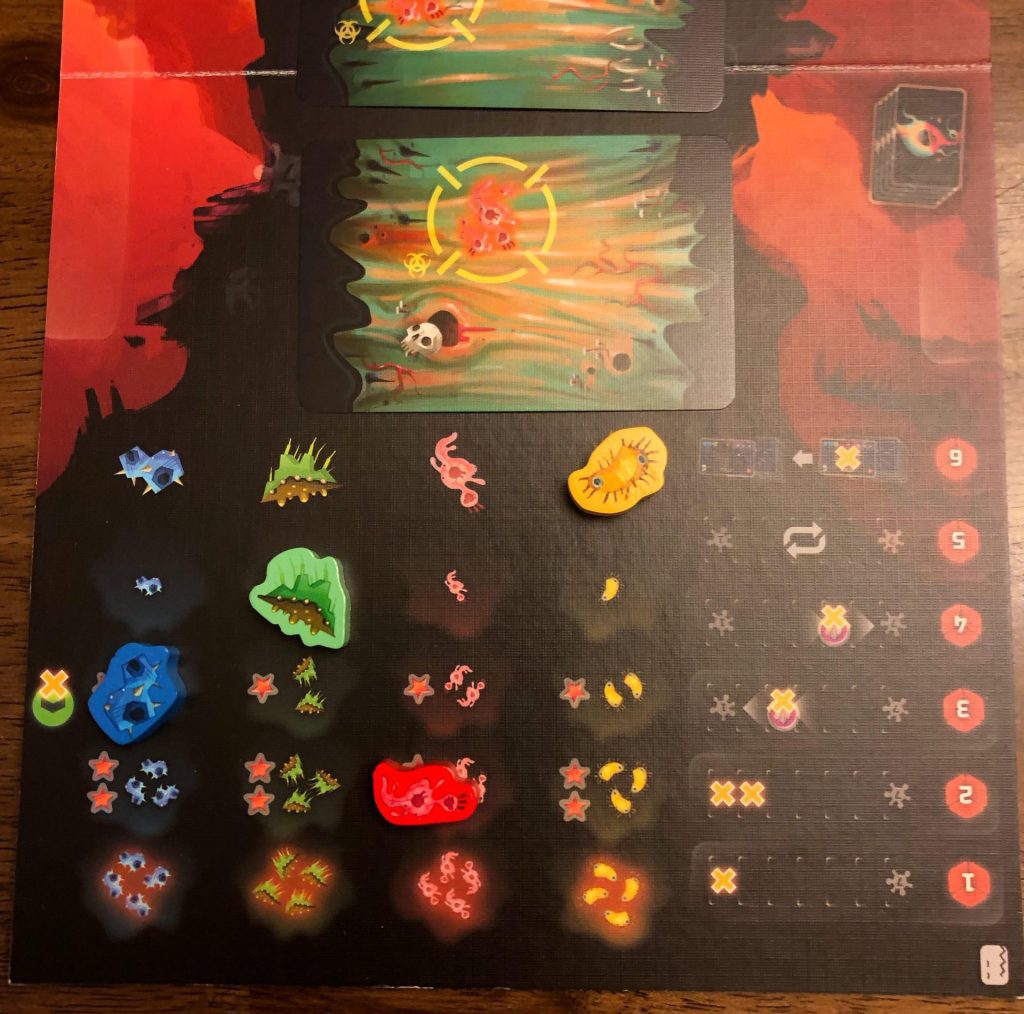
Beast Mode
On their turn, the Beast plays Stomach cards from their hand of 7 to fill any missing spaces in the Digestive Tract. This determines what the Miner will have access to in the Digestive Tract on their turn. The Beast may also “overflow” the Tract by playing extra cards once all 7 spaces are filled, pushing the previously placed cards off the edge of the board. This allows them to move cards to a better position or discard cards that the Miner might want.
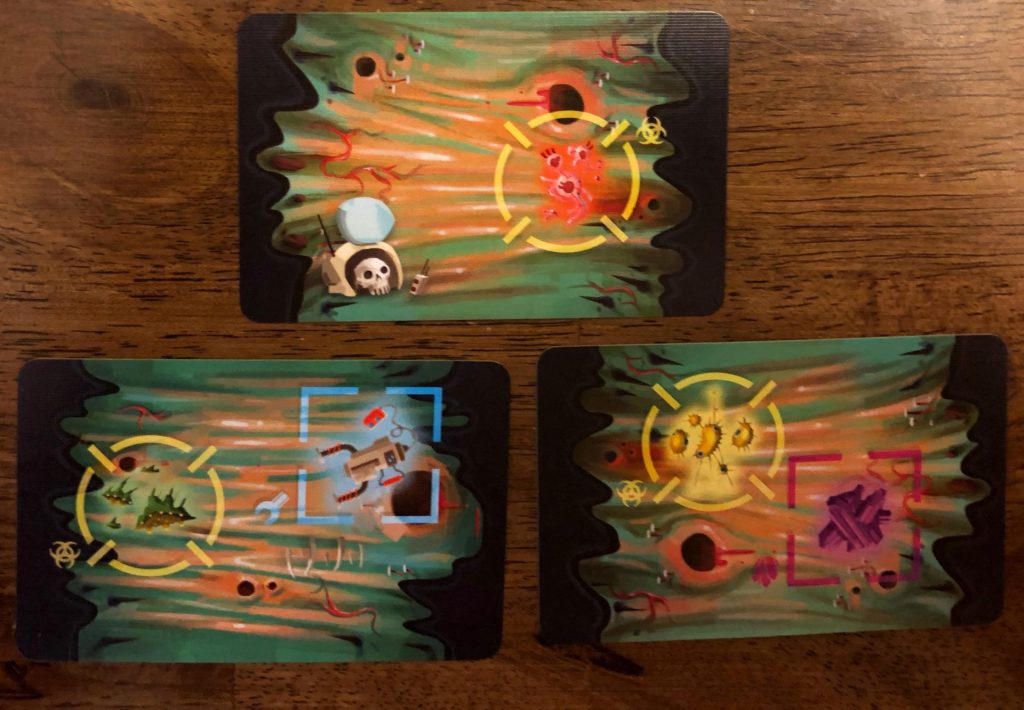
After placing their cards, the Beast may claim one of the three available Immune Response Cards. These are potent cards which not only give the Beast a variety of instant or ongoing effects, but also can lead to an automatic win if the Miner doesn’t stay on top of clearing them out.
The Beast must meet the requirements listed on the Immune Response cards, such as having two or more Bacteria of a single color in the Digestive Tract, before they claim it. They must also pay an Energy cost. Each Crystal in the Digestive Tract generates one Energy and the Beast player may also discard Stomach cards that don’t have a Crystal on them in order to generate additional Energy (one per card discarded). The Beast refills their hand during their turn, so spending these cards lets them turn dead weight into valuable progress.

Lastly, the Beast plays a Mutation card face-down. These cards show the various Bacteria colors, with one card showing no color at all. If the Miner takes damage from a Bacteria of the matching color at the end of their turn, they’ll suffer an additional effect. However, the Mutation card is discarded at the end of the round (except for the colorless card which returns to the Beast’s hand), meaning that the Beast has a limited number of opportunities to get it right.
Curiouser and Curiouser
The asymmetric nature of So, You’ve Been Eaten makes it difficult to see how it all fits together until the first game. While it’s not particularly complex, the ways in which the two roles interact with each other isn’t immediately obvious. Each player’s turn is almost misleadingly simple as well, particularly the Beast who seems fairly limited to playing cards and hoping for the best.
After a play or two, though, the rules start to crystallize and something much sharper and more interesting is revealed. Suddenly the table is teeming with little tactical delights. The Miner bumps a threatening Bacteria to the back at the cost of not taking out a dangerous Immune Response. The Beast plays their whole hand to the Tract, suddenly pushing a much-needed Crystal off the board. The Miner sacrifices the opportunity to grab a Tool to Eliminate three Bacteria, forcing the Beast to play more cards on their turn, which means they have to play that Crystal they were holding, but that gives them the Energy to buy a good Immune Response card… All these small decisions add up, over time, and it’s easy to miss out on how tightly woven they all are, how dense the connective tissue is between the two players.
So, You’ve Been Eaten reminds me of some of my favorite games. It has all the tempo management of Magic: the Gathering and the intricate tactical layers of Mandala. The dystopian space capitalism theme reminds me of the best work from Czech Games Edition, most notably the incomparable Galaxy Trucker. Unfortunately, So, You’ve Been Eaten has a few problems that hold it back from ranking alongside these Top 10 candidates.
Perhaps my biggest complaint concerns the two rulebooks that the game uses. They’re not bad, per se, but I did have trouble easily finding what I needed. That’s due in part to the asymmetric nature of the game, especially since there’s so much overlap between what happens on each player’s turn.

For example, the Beast wins if any Bacteria on their track reaches the fourth space. This is a major part of the Beast’s role. Yet the rules for that track fall under the Miner section, since the Bacteria attacks during the Miner’s turn rather than the Beast’s. (A particularly odd choice since that event could easily take place at the start of the Beast’s turn instead.) Ah, but wait, because the rules for the Beast’s Mutation cards, which amplify the Bacteria attacks, are found under the Beast section since the Beast plays the Mutation card on their turn. And then, after reading those, it’s back to the Miner section to read the rules around downgrading actions as a result of the Mutation. Whew!
I understand the difficulty of managing such a complicated back-and-forth inside of a rulebook. I don’t doubt that everyone who worked on the rulebooks did their absolute best to make them clear, concise, and easy to reference. For me, I think I would have liked to see a clear outline of gameplay that would make learning the game more manageable. I would also appreciate more duplication of information. Gameplay is fairly quick, so time spent paging backwards and forwards through the rulebook (let alone accessing the second rulebook) feels like it kills the game’s momentum.
The other major problem I have with this game is a little thornier: the player count.
It Takes 0-2 to Tango
So, You’ve Been Eaten includes rules for solo play in either role against a programmed “bot” and even a zero-player option where a human simply runs the two bots against each other. My understanding is that this mode was largely developed by famed solo designer Dávid Turczi. As is typical of his work, the bots run fairly quickly using a simple decision tree that is straightforward to handle.
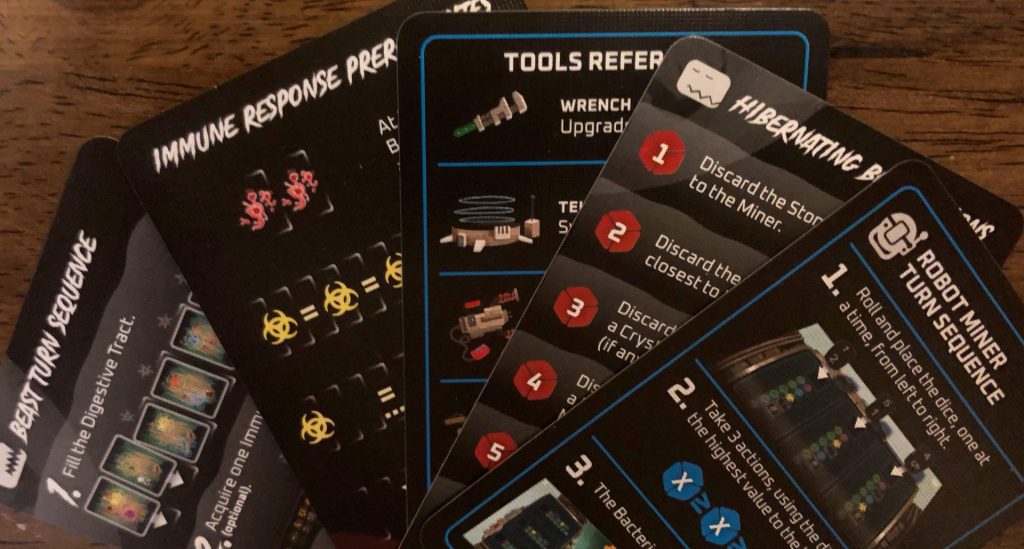
In the case of the Hibernating (AI) Beast, the player rolls a single die to determine the Beast’s action for the turn. These actions typically discard one or more Stomach cards. The player then fills the Digestive Tract using Stomach cards from the deck. Lastly, the Beast automatically claims a single Immune Response card from the deck, regardless of Energy.
The Robot (AI) Miner is similarly easy to manage. The player rolls three dice, one at a time, placing them in the three columns on the Robot Miner board. The player then resolves the columns in order of descending die value, following a simple checklist to determine what the AI does. Once an action is taken, that column’s die is discarded. Since each column is different, this method actually leads to surprisingly varied gameplay. The Robot Miner gathers Crystals, similar to how a human player would, to secure the win. It also has a separate Robot Replication track on which it advances whenever it would pick up a Tool. Reaching the final spot on this track is an automatic win for the Miner, though a human-led Beast can discard certain combinations of Bacteria on their turn to lower the AI’s position on the track.
Unfortunately, in either case, solo play misses out on a significant amount of what makes the two-player game hum. There’s no back-and-forth, no second-guessing the AI. Though a skilled human player might be able to anticipate or even influence the AI slightly through careful decision-making, it’s nowhere near as satisfying without that interactivity. And some of the more interesting decision spaces, like which Mutation card to play as the Beast, simply aren’t a part of the solo game at all.

Of the two roles, I think playing as the Miner against a Hibernating Beast is preferable, so in a pinch I would consider playing it this way. However, there are so many great solo games in the world (including quite a few with Turczi-made solo modes) that I’d much rather grab than this one.
As for the zero-player option: it’s a cheeky gimmick for marketing purposes but not much more. I did it once for this review and, despite the fact that it works surprisingly well mechanically, I can’t see any situation in which I would want to do it again. My playing time is limited enough that watching a “game” between two non-entities, with no tactical or strategic thought and not even the veneer of a decent conversation, feels like a waste.
Wink Wilkinson’s Weird World
So, You’ve Been Eaten is one of the weirder games in my collection. I’m not just talking about the theme: this game is weird to learn, weird to play, and weird to teach. It’s simultaneously way more complicated than it needs to be and way less complicated than it seems. With a middling solo experience and some serious rules confusion, it’s hard for me to easily recommend it. Which is disappointing, because I really enjoy playing it.

I appreciate what So, You’ve Been Eaten does right. It’s a bold, unorthodox game that immediately grabs your attention. It absolutely oozes theme, from the gorgeous illustrations by Kwanchai Moriya to the genuinely funny writing in the rulebooks. The core gameplay is intriguing, with that distinct Scott Almes style. The dueling nature of the game feels well-calibrated to me; both players have a good range of options to mess with each other or advance their own plans. If there’s an imbalance between the two roles, it wasn’t apparent in my plays.
All in all, I think So, You’ve Been Eaten is a game I’ll want to keep even if it rarely hits the table. It’s a great display piece, a quirky conversation starter that fills its particular niche well. Under the right circumstances, it has the potential to be one of the best games in my collection. Failing that, it’s at least the strangest.


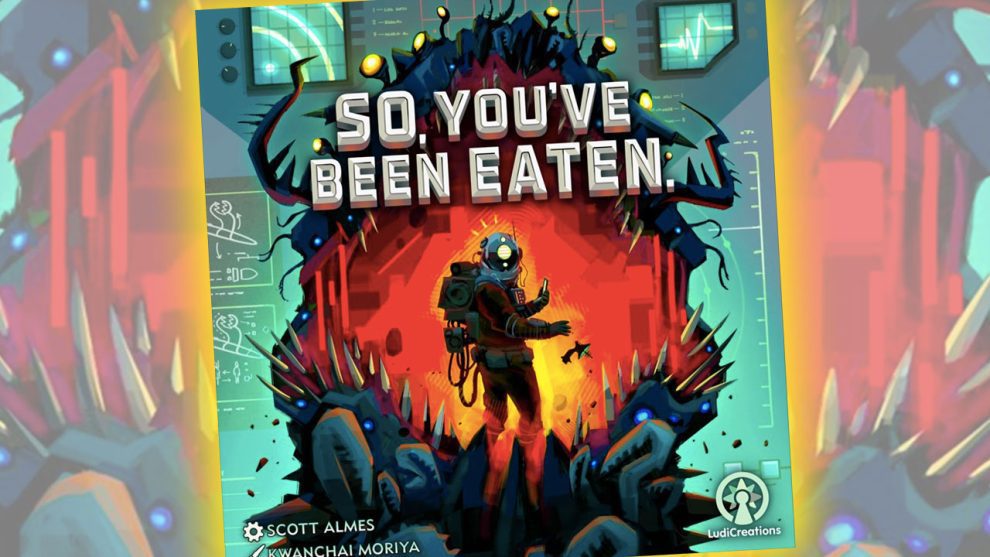

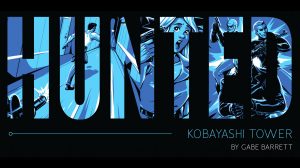







Add Comment